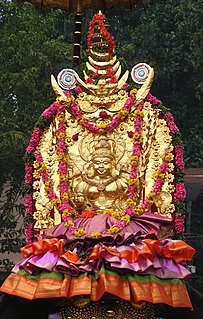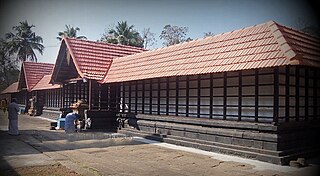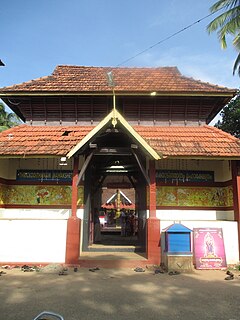
Thirunakkara is the name of an area of the city of Kottayam in Kerala, India. It is best known for Thirunakkara Sree Mahadevar Temple, dedicated to Shiva. The temple hosts an annual ten-day festival ending with the aaraattu ritual of dipping an idol of a deity into a river or temple tank, which includes a procession of nine decorated elephants. The festival is a celebration of Shiva's wedding to Parvati and is dedicated to Shiva. During the festival, traditional Keralan dances such as Mayilattom and Velakali are performed within the temple premises in the evening. Another major attraction is the Kathakali performances during the festival.
Azhakodi Devi Temple is a Hindu temple in Thiruthiyadu, Thiruthiyadu, Kozhikode, Kerala, India. It is about 1.5 km away from the Mofussil bus stand and 2.5 km from the KSRTC Bus stand in the Kozhikode city.

Kumaranalloor is a suburb of Kottayam city, Kottayam taluk, Kerala, India. Kottayam city is just 5 km south of Kumaranalloor. The region was administrated by the Kumaranallur grama panchayath till 2010, before the local self-governing body was merged into the Kottayam municipality. The former Panchayath office now exists as the regional administrative office for the municipality. The village is situated on the banks of Meenachil river.

The Panachikkadu Temple, also known as the Dakshina MookambikaTemple, is a Hindu temple dedicated to the goddess Saraswati. The temple is located in the southern region of the Indian Peninsula, in Panachikkad in Kottayam District, Kerala, India. It is one of the most prominent Saraswati temples for devotees in Kerala. But, the main deity of the temple is Lord Vishnu, who was installed long before Goddess Saraswati. Still the temple is known as Saraswati temple, due to the popularity of the Goddess. There are sub-shrines for Lord Shiva, Lord Ganapathi, Lord Ayyappan, Snake deities and Panachikkattu Yakshi inside the temple.

Vilwadrinatha Temple is a Hindu temple located in Thiruvilwamala, Thrissur district of Kerala. Lord Rama, the seventh avatar of Lord Vishnu, and his brother Lord Lakshmana are the main deities of this temple. This is one of the four major temples in Kerala dedicated to Lord Rama, the other three being Thriprayar, Kadavallur and Thiruvangad temples, and also one of the rarest temples in India itself which houses Lord Lakshmana. The temple is situated on the middle of Thiruvilwamala village, on the top of a hill 100 ft above the sea level. Bharathappuzha, the second largest river in Kerala, flows through the northern side around 3 km away from the temple, and as the temple is situated on the top of a hill, the river can be clearly seen from the temple.

Anandavalleeswaram Sri Mahadevar Temple in Kollam city is one of the ancient Hindu temples in Kerala, India. Lord Siva and Goddess Anandavally are the main deities of the temple. According to folklore, sage Parashurama has installed the idol of Lord Shiva. The temple is a part of the 108 famous Shiva temples in Kerala. It is located at Anandavalleeswaram, a major neighborhood of Kollam city, that comes to the west side of Kollam Collectorate.

The Vaikom Mahadeva Temple is a temple for the Hindu god Shiva in Vaikom, Kerala, India. The temple, along with Ettumanoor Siva Temple, Kaduthuruthy Thaliyil Mahadeva Temple is considered a powerful trisome. The belief is that if a devotee worships at these three temples before 'Ucha pooja', all the wishes are fulfilled.

Kaviyoor Mahadevar Temple is one of the important Siva temples in Kerala, located in Kaviyoor, Tiruvalla Pathanamthitta District, Kerala, India. It is commonly called Thrikkaviyoor Mahadeva Temple. The main deity is Lord Mahadeva (Shiva) with Parvathi.The temple is well known for the Hanuman temple situated inside the temple complex. Kaviyoor Temple is one of the important Special Grade temples under the Travancore Devaswom Board.

Thumpamon Vadakkumnatha Temple is an ancient temple near Pandalam in Kerala, India. This temple has two Sreekovils. Both Sreekovils are round (vatta). It is an age old temple whispering several fascinating legendary fables of the bygone eras.

Ettumanoor Mahadeva temple is an ancient Shiva temple in Kottayam, Kerala, India. Temple tradition has it that the Pandavas and the sage Vyasa had worshipped at this temple. The name of the place has its origin from the word manoor, which means "the land of deer." The temple is one of the major Shiva temples in Kerala, along with Vaikom Temple, Chengannur Mahadeva Temple, Kaduthruthy Mahadeva Temple, Ernakulam Shiva Temple, Vazhappally Maha Siva Temple and Vadakkunathan temple.

Vazhappally Maha Siva Temple is a Hindu temple located in Vazhappally near Changanassery in Kottayam district in the Indian state of Kerala. The temple is administered by the Travancore Devaswom Board. The temple is believed to be constructed by the first Chera king of Kodungallur. The legends suggest that the installation of the idol of god Mahadeva (Shiva) was performed by Parasurama himself. This temple is one among the 108 Shiva temples established by Parasurama. It is one of the few temples in Kerala where two nalambalams and two flag-masts are dedicated. The temple, a Grama Kshetra, also contains some seventeenth century wood carvings depicting figurines from epics. A Vattezhuttu inscription on the northern part of the base of the cultural shrine indicates that the repairs were completed in Kollam Era 840 (1665 AD).

Thuravoor is a gram panchayat in the Pattanakkad Block of Cherthala Taluk of the Alappuzha District, State of Kerala, India. It comes under Aroor Assembly constituency. Thuravoor lies exactly between Kochi and Alappuzha. A four lane National Highway 47 passes through the village, which along with a railway station gives it excellent connectivity with the remainder of the state. Thuravoor is famous for the Narasimha Swamy temple which is dedicated to the fourth incarnation (avatara) of Vishnu, the Narasimha. The temple has two main deities, the Vadakkanappan and the Tekkanappan, which is rare among the temples of Kerala.

Brahmarakshasas are fierce demons in Hindu mythology.

Anikkattilammakshethram is a Hindu Temple situated in Anicadu Village, 3.5 km from Mallappally in Pathanamthitta district in the southern part of Kerala, India. Here, Adiparasakthi Sivan and benign Parvathi are worshiped with equal significance in one Sreekovil, which is one of the rarest of its kind in Kerala. Agnimahakalan and Agniyekshi are symbolized in these idols, each measuring about 4 feet and installed side by side. The demon-shaped Lord Shiva (Kiratha) has bow and arrow in His arms and Parvati has sword in Her hand. The temple, situated by the bank of river Manimala, is estimated to have come into existence around 1600 years ago during the early days of Edapally dynasty. Apart from the Deities in the main Sreekovil, there are Lord Siva, Bhadra, Nagaraja, Rakshasas and Yekshiamma in the sub-abodes in the courtyard.

Triprangode Siva Temple is a Hindu temple located at Triprangode, near Tirur, Malappuram district, Kerala. The ancient temple is situated 5 kilometres (3.1 mi) west of Tirunavaya railway station and 10 kilometres (6.2 mi) south of Tirur railway station. It is one of the most important Hindu pilgrimage centres in northern Kerala. Kokila Sandeśa of Uddanta Sanstrikal mentions Triprangode among other major destinations in the region. Inscriptions of the Later Chera ruler Goda Ravi Varma were discovered from the Triprangode Siva Temple. Later, the region formed a part of the Kingdom of Tanur (Vettathunad), who were the vassals of the Zamorins of Calicut. The main army led by the Zamorin camped at Triprangode during the Thirunavaya Wars of the 14th century.
The Mithrananthapuram Trimurti Temple is a temple complex in Thiruvananthapuram, Kerala, India. It is a temple in where devotees get to offer worship to all the three Trimurti deities, namely,. The Temple is located on the western side of Sri Padmanabhaswamy temple in Thiruvananthapuram.

Thrikodithanam Mahavishnu Temple is a Hindu temple dedicated to Vishnu and located in Thrikkodithanam, Kottayam District, Kerala, South India. Constructed in the Kerala style of architecture, the temple is glorified in the Divya Prabandha, the early medieval Tamil canon of the Azhwar saints from the 6th–9th centuries AD. It is one of the 108 Divyadesam dedicated to Krishna, an avatar of Vishnu, who is worshipped as MahaVishnu. The nearest railway station to the temple is located in Changanassery, while the nearest airport is Cochin International Airport.
Reflecting the religious constitution of the population, a large number of Hindu temples and Christian churches dot the townscape of Kottayam district. Some of them are the Thirunakkara Mahadeva temple, Kumaranalloor Devi temple, Thiruvarrpu Sri Krishna Temple, Thaliyil Mahadeva Temple, Pallippurathukavu Bhagavathi Temple, Elia Cathedral, Kottayam Valiya Pally, Manarcad Cathedral, Cheriya Palli, CSI Holy Trinity cathedral, Puthuppally St. George Church and Thazhathangadi Juma Masjid. All the temples of Kottayam were also built under royal patronage of Hinduism during the 2nd millennium.
Sree Rama Swami Temple is an ancient Hindu temple located in Ramapuram village in Meenachil tehsil and near Pala in Kottayam district in the Indian state of Kerala. The temple has Lord Rama as principal deity, facing the east, who is in a four-armed form, Chathurbahu. It is managed by a trust called Ramapuram Devaswom consisting of three Nambudiri families of Amanakara mana, Kunnoor mana and Karanattu mana.

















